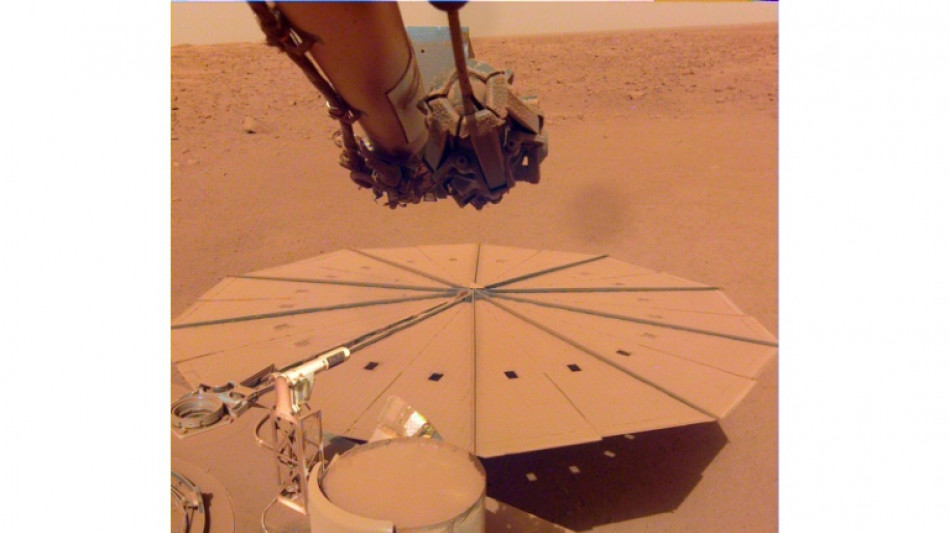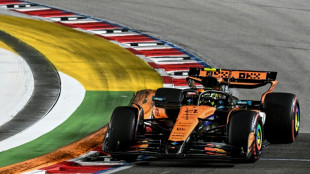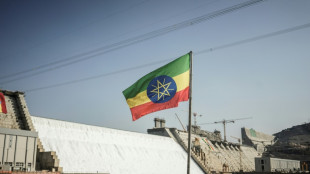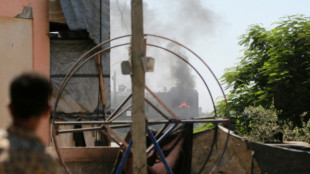
-
 Piccioli sets new Balenciaga beat, with support from Meghan Markle
Piccioli sets new Balenciaga beat, with support from Meghan Markle
-
Lammens must be ready for 'massive' Man Utd scrutiny, says Amorim

-
 Arteta 'not positive' after Odegaard sets unwanted injury record
Arteta 'not positive' after Odegaard sets unwanted injury record
-
Slot struggles to solve Liverpool problems after third successive loss

-
 Netanyahu hopes to bring Gaza hostages home within days as negotiators head to Cairo
Netanyahu hopes to bring Gaza hostages home within days as negotiators head to Cairo
-
Ex-NFL QB Sanchez in hospital after reported stabbing

-
 Liverpool lose again at Chelsea, Arsenal go top of Premier League
Liverpool lose again at Chelsea, Arsenal go top of Premier League
-
Liverpool suffer third successive loss as Estevao strikes late for Chelsea

-
 Diaz dazzles early and Kane strikes again as Bayern beat Frankfurt
Diaz dazzles early and Kane strikes again as Bayern beat Frankfurt
-
De Zerbi living his best life as Marseille go top of Ligue 1

-
 US envoys head to Mideast as Trump warns Hamas against peace deal delay
US envoys head to Mideast as Trump warns Hamas against peace deal delay
-
In-form Inter sweep past Cremonese to join Serie A leaders

-
 Kolisi hopes Rugby Championship success makes South Africa 'walk tall' again
Kolisi hopes Rugby Championship success makes South Africa 'walk tall' again
-
Ex-All Black Nonu rolls back the years again as Toulon cruise past Pau

-
 Hundreds of thousands turn out at pro-Palestinian marches in Europe
Hundreds of thousands turn out at pro-Palestinian marches in Europe
-
Vollering powers to European women's road race title

-
 Struggling McLaren hit bump in the road on Singapore streets
Struggling McLaren hit bump in the road on Singapore streets
-
'We were treated like animals', deported Gaza flotilla activists say

-
 Czech billionaire ex-PM's party tops parliamentary vote
Czech billionaire ex-PM's party tops parliamentary vote
-
Trump enovys head to Egypt as Hamas agrees to free hostages

-
 Arsenal go top of Premier League as Man Utd ease pressure on Amorim
Arsenal go top of Premier League as Man Utd ease pressure on Amorim
-
Thousands attend banned Pride march in Hungarian city Pecs

-
 Consent gives Morris and Prescott another memorable Arc weekend
Consent gives Morris and Prescott another memorable Arc weekend
-
Georgian police fire tear gas as protesters try to enter presidential palace

-
 Vollering powers to European road race title
Vollering powers to European road race title
-
Reinach and Marx star as Springboks beat Argentina to retain Rugby Championship

-
 Russell celebrates 'amazing' Singapore pole as McLarens struggle
Russell celebrates 'amazing' Singapore pole as McLarens struggle
-
Czech billionaire ex-PM's party leads in parliamentary vote

-
 South Africa edge Argentina to retain Rugby Championship
South Africa edge Argentina to retain Rugby Championship
-
'Everyone's older brother': Slipper bows out in Wallabies loss

-
 Thousands rally in Georgia election-day protest
Thousands rally in Georgia election-day protest
-
Sinner starts Shanghai defence in style as Zverev defies toe trouble

-
 Russell takes pole position for Singapore Grand Prix as McLaren struggle
Russell takes pole position for Singapore Grand Prix as McLaren struggle
-
Robertson praises All Blacks 'grit' in Australia win

-
 Government, protesters reach deal to end unrest in Pakistan's Kashmir
Government, protesters reach deal to end unrest in Pakistan's Kashmir
-
Kudus fires Spurs into second with win at Leeds

-
 Rival rallies in Madagascar after deadly Gen Z protests
Rival rallies in Madagascar after deadly Gen Z protests
-
Egypt opens one of Valley of the Kings' largest tombs to public

-
 Ethiopia hits back at 'false' Egyptian claims over mega-dam
Ethiopia hits back at 'false' Egyptian claims over mega-dam
-
Sinner breezes past Altmaier to launch Shanghai title defence

-
 Czech ex-PM set to win vote, putting Ukraine aid in doubt
Czech ex-PM set to win vote, putting Ukraine aid in doubt
-
All Blacks down Wallabies to stay in Rugby Championship title hunt

-
 Gazans hail Trump ceasefire call as Hamas agrees to free hostages
Gazans hail Trump ceasefire call as Hamas agrees to free hostages
-
Zverev echoes Federer over tournaments 'favouring Sinner, Alcaraz'

-
 Yamal injury complicated, return date uncertain: Barca coach Flick
Yamal injury complicated, return date uncertain: Barca coach Flick
-
Conservative Takaichi set to be Japan's first woman PM

-
 Marsh ton powers Australia to T20 series win over New Zealand
Marsh ton powers Australia to T20 series win over New Zealand
-
Verstappen lays down marker in final Singapore practice

-
 French air traffic controllers cancel three-day strike
French air traffic controllers cancel three-day strike
-
'A bit unusual': Russia's Sochi grapples with Ukrainian drones


End of the line nears for NASA InSight Mars lander
After some four years probing Mars' interior, NASA's InSight lander will likely retire this summer as accumulated dust on its solar panels saps its power.
The lander will, however, leave behind a legacy of data that will be tapped by scientists around the world for years to come, helping to improve our understanding of planet formation, NASA said, while announcing on Tuesday the imminent end to InSight's science operations.
Equiped with an ultra-sensitive seismometer, InSight recorded more than 1,300 "marsquakes," including a magnitude 5 quake on May 4, the largest so far.
But around July, the seismometer will be turned off.
The lander's energy level will then be checked about once a day, and some pictures may still be taken. Then by the end of 2022, the mission will be completely stopped.
The cause: the accumulation over months of Martian dust on the lander's two solar panels, each measuring about seven feet (2.2 meters) wide.
InSight, which is already running on only a tenth of the energy it had at the beginning, will soon find its batteries drained.
The speed at which dust accumulated corresponded more or less to what had been estimated by NASA.
The lander got a new lease on life around a year ago, when its robotic arm was put to new and unplanned use to remove some dust from the solar panels, extending the mission.
The maneuver -- employed six times successfully -- saw the arm use dust itself to clear the panels, as it scooped up some martian soil and gently dropped onto the robot so the dirt was blown across the solar panels, clearing parts of their surface.
Adding something to the lander specifically to clean the panels was forgone due to costs, explained Bruce Banerdt of NASA's Jet Propulsion Laboratory, during a press conference Tuesday.
Such a mechanism would leave "less to put into the science instruments," he said.
- 'Treasure trove' -
InSight, one of four missions currently on the Red Planet -- along with the US rovers Perseverance and Curiosity, and China's Zhurong -- arrived on Mars in November 2018.
Its seismometer, made in France, has since paved the way for great advances.
"The interior was kind of just a giant question mark," said Banerdt, who has worked on the InSight mission for more than a decade.
But thanks to InSight, "we've been able to map out the inside of Mars for the very first time in history."
Seismic waves, varying based on the materials they pass through, offer a picture of the interior of the planet.
For example, scientists were able to confirm that the core of Mars is liquid and to determine the thickness of the Martian crust -- less dense than previously thought and likely consisting of three layers.
The magnitude 5 quake in early May was much larger than all those previously recorded and close to what scientists thought would be the maximum on Mars, though it would not be considered a huge tremor on Earth.
"This quake is really going to be a treasure trove of scientific information when we get our teeth into it," Banerdt said.
Earthquakes are in particular caused by plate tectonics, he explained. But, they can also be triggered when the Earth's crust moves due to temperature anomalies caused by its mantle.
It is this type of vibration that scientists think they are dealing with on Mars.
Not all of InSight's scientific operations have gone smoothly, however, such as when its heat probe had trouble being successfully buried below the surface to take the planet's temperature because of the composition of the soil where the robot landed.
Regardless, in light of the seismometer's success, NASA is considering using the technique elsewhere in the future, said Lori Glaze, director of NASA's Planetary Science Division.
"We'd really like to set up a complete network on the moon to really understand what's going on there."
I.Meyer--BTB




